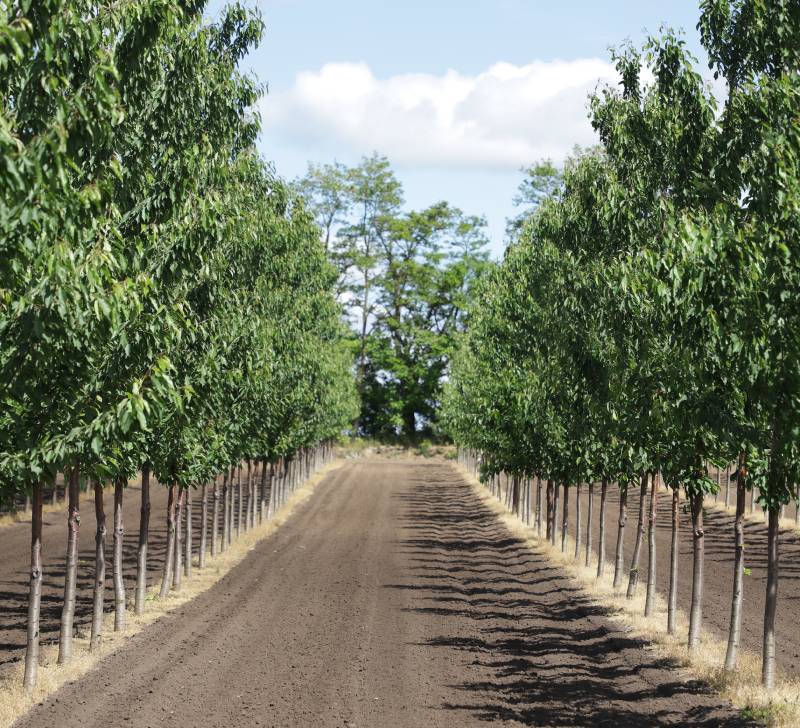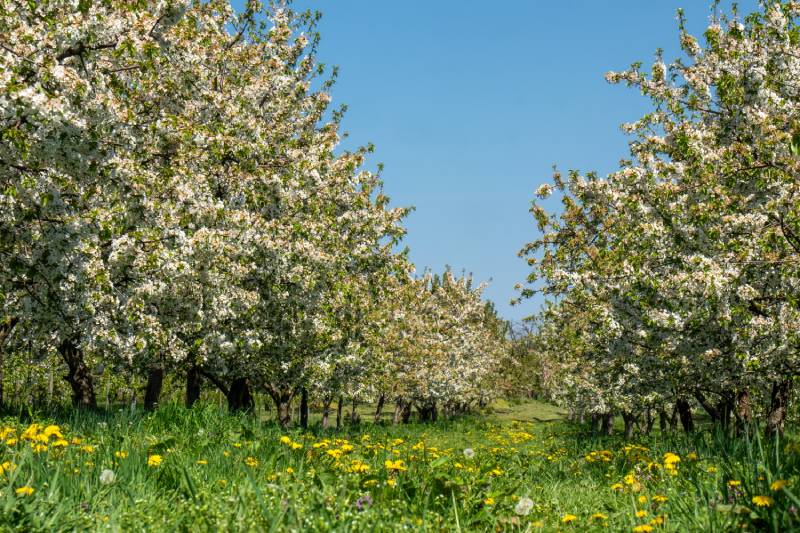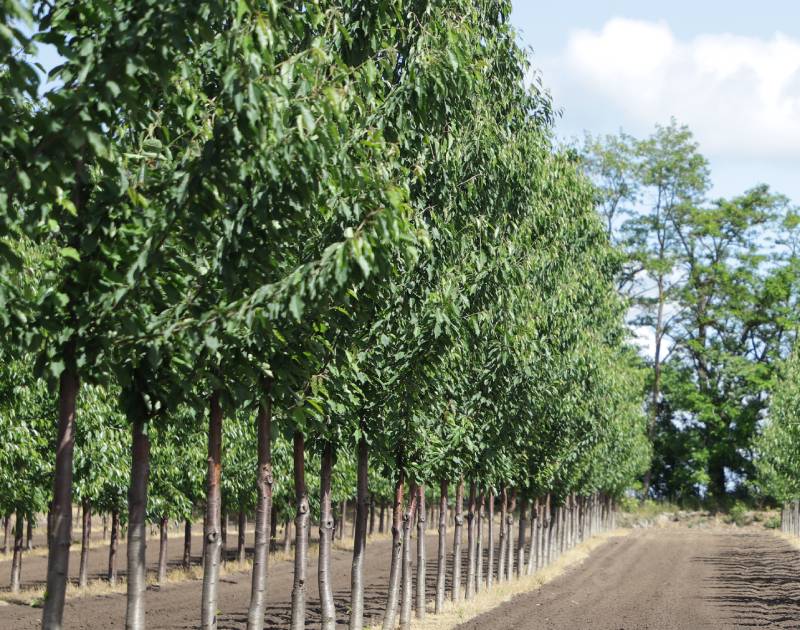The ROYAL AVIUM Cherries are superior trees with above-average qualitative and quantitative traits. The selection was made by the forestry genetic breeding institute in Graupa from 1992 to 2004 in Saxony, with additional consideration of vitality and health. A comparison test at two sites showed the significant superiority of the ROYAL AVIUM Cherries in key economic traits compared to a co-planted offspring of Bird Cherries. The Bird Cherry clones grouped under the name ROYAL AVIUM Cherry surpass the comparison standard in at least two of the four examined quality and growth characteristics.
Darüber hinaus sind ROYAL AVIUM Kirschen wie alle Vogelkirschen hitze- und trockenheitstolerant. Sie weisen gegenüber „normalen“ Vogelkirschen eine deutlich bessere Schaftform und geringere Tendenz zur Steil- und Grobastbildung auf, was die Holzqualität und somit den wirtschaftlichen Wert erhöht. Für bestmögliche Wuchsergebnisse benötigt sie mit zunehmendem Alter viel Licht und eine freie Krone. Ihre Vermehrung erfolgt durch vegetative Mikrovermehrung ohne gentechnische Veränderung.
Initially cone-shaped, later broad, spherical crown; initially smooth, dark red to gray-brown glossy bark with narrow, horizontally aligned cork warts that detach horizontally from the trunk; dead shoot holders
Fast-growing until the age of 40
Strong heart root with well-developed, shallow spreading lateral roots
With ROYAL AVIUM Cherries, an average tree height of up to 28 meters is possible within 40 years
Prefers summer-warm, nutrient-rich, moderately fresh to fresh sites with high base saturation, primarily in the colline zone, but also thrives on moderately acidic, low-lime sites
Waterlogged and surface-compacted soils are unsuitable for successful cultivation
In youth, it is susceptible to late frost
The Bird Cherry can tolerate partial shade in its early youth, but also full light. From the thickening phase onwards, it becomes a true light-loving tree, and its crowns themselves are relatively translucent
Plant as early in the year as possible, and avoid autumn planting under all circumstances
Planting pattern of at least 3 m x 3 m recommended
Plant high, as it is sensitive to burying/mounding around the root flare.
Browsing and fraying protection is absolutely necessary
Terminal on long and short shoots
Up to 15 cm long, 7 cm wide, pointed at the tip, serrated edge, with 2–3 red nectar glands on the petiole
Dark green upper side with a lighter green underside, turning intense yellow, bright orange, to fiery red in autumn
Deciduous tree species
Conspicuous white hermaphrodite flowers on short shoots, 2.5 to 3.5 cm in diameter, in umbel-like
Flowers emerge along with leaf sprouting from April to May, depending on altitude
Up to 1 cm thick, round to heart-shaped, single-seeded drupe, black-red with juicy flesh and a light, oval stone core
Fruit ripening from late May to mid-August
Due to self-sterility, neither self-pollination nor cross-pollination between cherries of the same genotype is possible
Particularly beautifully colored and warm-toned wood, freshly cut with no distinct separation between the yellowish to red-white sapwood and heartwood
Initially yellowish to light reddish-brown heartwood darkens to deep reddish-brown to golden brown under light exposure
Well-visible annual ring boundaries
Low to no durability in outdoor conditions, unrestricted use indoors
Highly decorative furniture and interior wood with a wide range of combination possibilities with other wood types, further use in musical instrument making, and the production of decorative and functional items
One of the most valuable hardwoods, traded as roundwood, sawn timber, and veneers
A sensible alternative to tropical woods for indoor use
Very high value creation for good trunk qualities, with no significant differences in structure and coloration between wild-grown and open-grown bird cherries


In spring, a forage source for bees, bumblebees, and other insects
A food source for many bird and mammal species, as well as caterpillars
Habitat for fungi, bacteria, and virus species
Old bird cherry trunks and stumps serve as replacement habitats for stag beetles
As a light-demanding tree species with high heat and drought tolerance, it is suitable for cultivation on open land, initial or reforestation projects, as well as in agroforestry.
The ROYAL AVIUM has identical requirements for silvicultural treatment as the bird cherry and possesses very high potential for valuable timber when consistently managed and cared for (value pruning).
Exceptionally well-suited for group or clump planting in larger, minimally shaded open areas of at least 0.3 hectares in size, within the natural regeneration of other tree species, or as advance regeneration in gaps.
Preferred establishment in mixture with slow-growing deciduous trees, such as the winter linden, in the understory, to avoid rapid integration of the mixed tree species into the crowns of the bird cherries.
Planting at least in a pattern of 3 m x 3 m with 1,111 plants per hectare, up to 5 m x 5 m with 400 plants per hectare when using large plant sizes (80 – 120 cm).
Prefer planting methods that result in large planting holes, plant high, as they are sensitive to burying/mounding around the root flare.
Browsing and fraying protection is absolutely necessary
Consistently remove competing vegetation, such as grass covers, in the first few years of growth to avoid damage from compression and rodents
The ROYAL AVIUM, like all bird cherries, requires plenty of light as it ages. Early and regular spacing regulation and thinning are therefore necessary. The goal is to create sufficient growing space for the best trees (future or Z-trees) through consistent promotion and crown release during the first half of the stand's life.
In young stand care (2 to 6 meters in height), qualitatively unsatisfactory or diseased pre-existing bird cherries should be removed, as well as competition-strong, heavily suppressing softwood trees. In individual cases, defective bird cherries may undergo formative pruning if they are potential future (Z-tree) candidates.
In the thinning stage (height 6 to 12 meters), starting at a height of 6 meters, the first step is to select and mark 100 to 150 future (Z-tree) candidates and prune them to a height of 3 meters. Subsequently, the Z-tree candidates are promoted by removing one to two competing trees, exclusively from the dominant trees. In the second step, at around 9 meters in height, after critical review and pruning of the still suitable Z-tree candidates to a height of 4.5 meters, a high-thinning-type intervention should be carried out.
The following strong high-thinning interventions (from 12 meters in height) for the confirmed Z-trees begin with a third pruning to at least 6.5 meters in height, with the goal of expanding the crowns and maintaining sufficiently long, green crowns. Initially, the high-thinnings are carried out every 3 to 5 years according to the growth dynamics of the bird cherries. From a height of about 22 meters, the thinning occurs every 5 to 7 years.
The pruning is carried out for forest protection reasons at the end of June/beginning of July. The branch diameter should be under 3 cm.
Specifically for the Royal Avium, the production of valuable timber with a clear bole length of at least 6.5 meters and a DBH (diameter at breast height) of at least 40 cm in 40 to 80 years is of crucial economic importance. This requires early and frequent pruning of the lower trunk sections at short intervals until a clear trunk piece of 6 to 8 meters in length is achieved. In some cases, due to the high value expectations, pruning of shorter ground trunk sections from 4 meters in length may also be promising.

Sources and further information
Aas, G. (2010): Die Vogelkirsche (Prunus avium) und ihre Verwandtschaft. LWF-Wissen 65, Bayerische Landesanstalt für Wald und Forstwirtschaft, 7-12 (https://www.lwf.bayern.de/service/publikationen/lwf_wissen/016733/index.php).
Anonymus (2011): Die Vogelkirsche (Prunus avium L.) Praxis-Infoblatt zur Wertholzproduktion. ForstBW Praxis, 1/2011, 5 S. (https://www.waldwissen.net/de/waldwirtschaft/waldbau/ bestandespflege/die-vogelkirsche-praxis-infoblatt).
Dong, P. H., Eder, W., Muth, M., Krämer, R., Weber, D., Früh, H. (2009): Vogelkirschen-Anbauversuch im Forstamt Kusel. In: Dong, P. H. (Hrsg.): Zum Anbau und Wachstum von Vogelkirsche und Birke. Mitteilungen aus der Forschungsanstalt für Waldökologie und Forstwirtschaft Rhenland-Pfalz, 67/09, Trippstadt, 8-38.
Jeske, H., Grosser, D. (2010): Das Holz des Kirschbaums – Eigenschaften und Verwendung. LWF-Wissen 65, Bayerische Landesanstalt für Wald und Forstwirtschaft, 64-69 (https://www.lwf.bayern.de/service/publikationen/lwf_wissen/016733/index.php).
Kleinschmit, J., Meier-Dinkel, A., Jorbahn, M. (2015): Entwicklung von Kulturen mit silvaSELECT-Vogelkirsche. AFZ-Der Wald 70, 44-46.
Otto, H.-J. (1988): anbau der Vogelkirsche in Niedersachsen. AFZ 43, 542-543.
Roloff, A. (2010): Die Vogel-Kirsche – Baum des Jahres 2010. Dr. Silvius Wodarz Stiftung „Menschen für Bäume“, Marktredwitz, 14 S.
Schmid, T. (2006): Prunus avium Linné, 1755. In: Schütt, P., Weisgerber, H., Lang, U., Roloff, A., & Stimm, B.: Enzyklopädie der Holzgewächse, ecomed-Verlag, Landsberg/Lech, 16 S.
Spellmann, H., Kleinschmit, J., Guericke, M., Rumpf, H., Wachter, H. (2004): Merkblatt Entscheidungshilfen zur Bewirtschaftung der Vogelkirsche in Nordwestdeutschland. Niedersächsisches Ministerium für den ländlichen Raum, Ernährung, Landwirtschaft und Verbraucherschutz, Hannover, 22 S.
Springmann, S., Morhart, Chr., Spiecker, H. (2015): Leitfaden zur Ästung von Edellaubbaumarten. Institut für Waldwachstum (Hrsg.), Freiburg i.Br., 2. Auflage, 10 S. (https://www.iww.uni-freiburg.de/leitfaden-wertholzproduktion-in-afs.pdf).